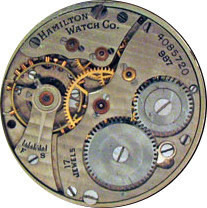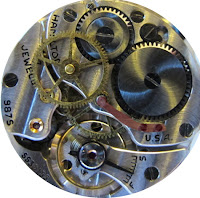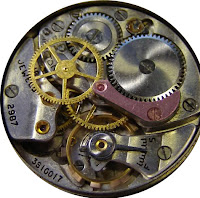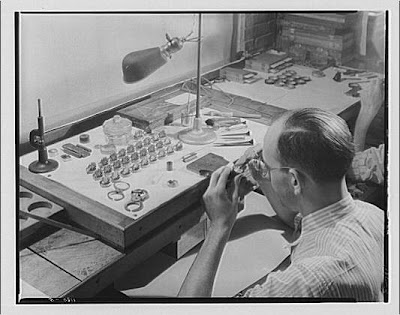The purpose of this article is to clear-up general misunderstandings about Hamilton 987 size 6/0 movements.
by Tom Adelstein
Much confusion exists about them. You need to know which 987 generation goes in which watches to make wise purchase decisions. Otherwise, you might win an auction thinking you bought a high priced model and later discover you bought a popularly priced wristwatch instead.
Hamilton produced six movements referred to as 987 calibers. They’re 17 Jewel movements and evolved from smaller pendant pocket watches. The company produced a size 6/0 movement for wristwatches known as the 986. Later, they produced a 19 Jewel version known as the 979. The 987 became the survivor but underwent various quality improvements over the course of its life cycle.
Hamilton Watches with 987 Movements
link to eBay search
The company made high-end wristwatches with 987 movements between 1924 – 1935. That changed when Wall Street Analysts spread the word that the country would enter the recovery phase of the business cycle in 1936. Hamilton’s management believed the same thing, which influenced changes made in their product strategy. Hamilton made the decision to enter the popular priced strap watch market with 10 karat gold-filled cases using 987 movements.
In the perception of consumers and Hamilton’s competitors, watches with 987 movements were commodities. Hamilton made significant enhancements to the 987, which improved its performance over it competitors. Hamilton believed that customers would be thrilled to buy a popularly priced watch with their best movement. When the company changed the letter affixed to the model, people thought the movement was downgraded. In fact, it was greatly improved.
Hamilton’s management expected consumers to return to jewelry stores and begin buying watches again. Unfortunately, the Depression didn’t just go away in 1936. The movement that some people believed help win the World War II, had an undeserved poor reputation between 1936 to 1941; until it drove military watches for the Allies. Even the UK bought Hamilton wristwatches with 987 movements for their pilots. That’s a pretty steep endorsement.
Hamilton also introduced its 14/0 sized rectangular movements – the 980 and 982 caliber models in 1936. They chose the rectangular movements for their high-end watches. That trend continued until 1941 when Hamilton shut down its consumer products group and dedicated its entire production facilities to the US Military. The Pentagon chose one of Hamilton’s 987 movements for all members of the armed forces at the start of US involvement in the war.
A colleague once told me to “stay away” from any 987 movements other than the original. Without much thought, I did that. I had no use for 987 movements with a letter next to the number. My colleague picked up that notion from his mentor, who picked it up from his mentor and so forth.
I found out that the oldest watchmaker of the bunch started practicing in the early 1900’s. He had no use for “them new-fangled Swiss improvements”. My colleague bought up all the original 987 movements he could find and used them in every 6/0 size case he had. I suggest that you don’t make the same mistake he did.
I wear an antique Hamilton watch daily – and why not? Compared to $5000 + wristwatches made and sold today, my 1938 Martin is a bargain. The US Military used that same movement in the watches our troops wore in World War II and from what I understand, they worked even when caked in mud.
 |
| 987 |
Hamilton 987-987(x) movements can be found in wristwatches made from 1924-1948. When you begin to see a letter after the 987 it means improved friction jeweling. The first 987 (1924-1929) had bezeled jewels or the kind held in place by a small ring over the jewel hole and held in place with screws. Hamilton stopped making the original model 987 in 1929 and introduced the “improved jeweling” or what we call friction jeweling. The jewel is held in place by friction between the jewel hole and the stone itself. That version of the movement is denoted as a 987 F, which Hamilton stopped producing in 1935. That year, Hamilton introduced a Swiss Elinvar hairspring. Hamilton denoted that model as a 987 E, which they stopped producing in 1937. Hamilton began producing a movement with the Swiss Elinvar hairspring and a monometallic balance and was designated as the 987 A.
| 987 A |
| 987 F |
Hamilton produced the 987A for the military during World War II and continued production until 1948. The 987A was similar to the earlier 987 models but had an Elivar Extra hairspring. The “A” was a different design, and only a few parts were interchangeable with the earlier models. Hamilton produced approximately 490,00 model 987As.
| 987 E |
Finally, Hamilton began producing a watch with a center or sweep second hand. That model carries the designation of a 987S. The Hamilton models with a sweep second hand (another military watch) were produced from 1940 to 1948. The 987A and 987S were fitted with Elinvar Extra hairsprings when they became available.
 |
| 987 S |
| Marine 2987 with hack |
 |
| 2987 WWII Movement |
 |
| A Hamilton watchmaker finishing off a 987 movement |
Copyright 2006-2017 | All Rights Reserved
